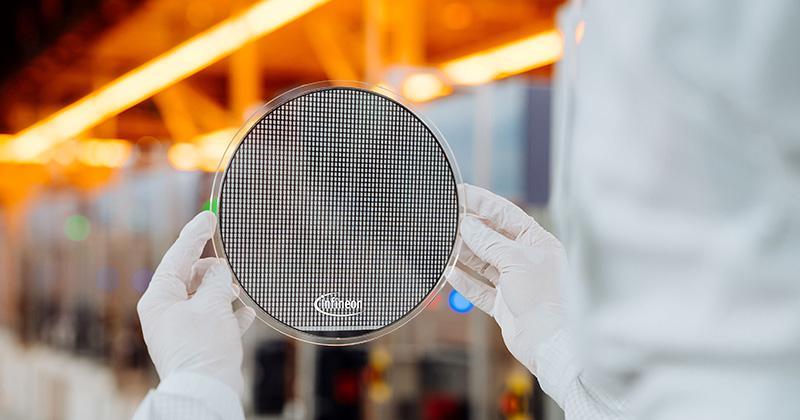
Soundskrit to Democratize Directional Audio With New MEMS Microphones
This week, Soundskrit, a MEMS microphones company based in Montreal, released two new MEMS microphone modules. Soundskrit built the new products, dubbed SKM1600 and SKM2600, around the "industry’s lowest-noise directional microphone" and take aim at consumer electronics applications like AR/VR devices and smart home devices.
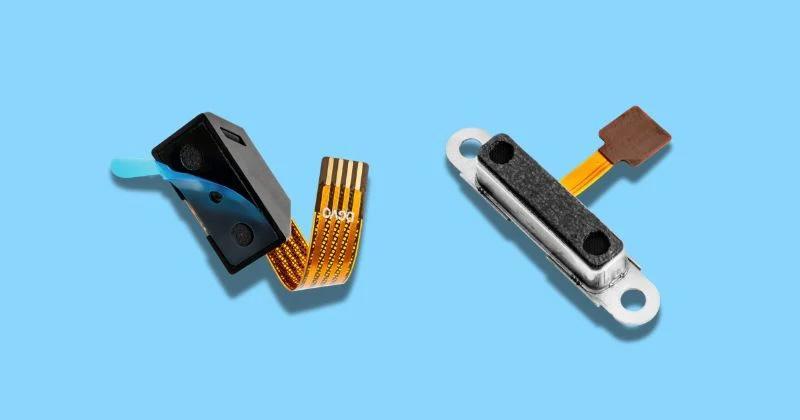
The SKM1600 (left) and SKM2600 (right).
All About Circuits spoke with Soundskrit co-founder and product lead Sahil Gupta to learn more about the releases firsthand.
SKM1600: An Analog Dipole and Omnidirectional Microphone
The SKM1600 module integrates advanced analog dipole and omnidirectional microphone technologies into a compact form factor.
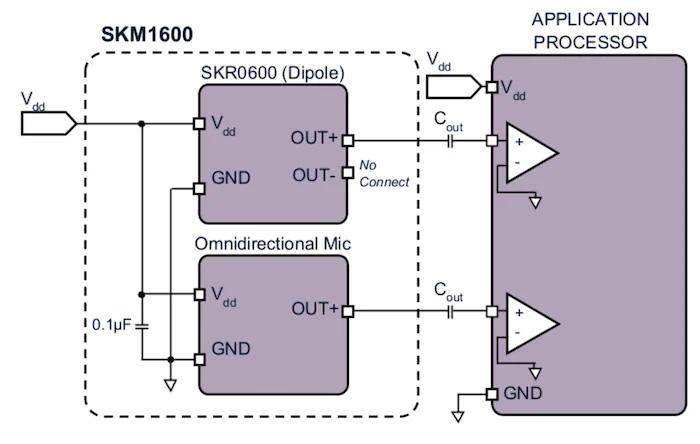
Typical application circuit of the SKM1600.
The device combines a SKR0600 dipole microphone configured in a single-ended output and a MEMS omnidirectional microphone—featuring signal-to-noise ratios of 65 dBA and 68 dBA, respectively.
“Most designers have to use two omni-microphones to get direction. We do it in one,” said Gupta. “We reduce the number of components, reducing the power consumption and the number of signals needed to process in the DSP.”
For noise isolation and beamforming capabilities, the solution offers a directivity index of 4.8 dB for the dipole component. Meanwhile, the omnidirectional microphone’s placement between the directional ports maximizes beamforming performance and supports diverse polar patterns, such as cardioid and hypercardioid, using Soundskrit’s SimplyClear software.
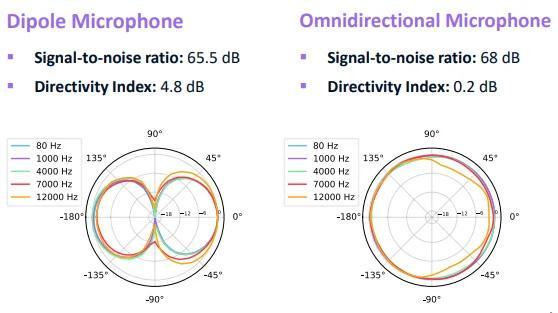
Polar patterns of the SKM1600 microphones.
The module measures 16.4 mm x 8.1 mm x 7.0 mm. It operates within a supply voltage range of 1.7 V to 3.6 V, with a low power draw of 235 µA at 1.8 V. Its layered stack-up design features precision-aligned acoustic channels to simplify integration while maintaining acoustic integrity.
The SKM1600 is available for analog output, and the SKM1610 is the same module but with PDM output.
SKM2600: An Analog Directional Microphone
The SKM2600 series, on the other hand, is an analog directional microphone module that comes in both dipole and hypercardioid variants and is engineered for consumer electronics. The dipole variant (SKM2600-DP) has a 65.5-dB SNR and 4.8-dB directivity index, while the hypercardioid (SKM2600-HC) variant has a 63.5-dB SNR and 5.3-dB directivity index). Users can achieve different beam patterns using different acoustic meshes on one of the sound ports.
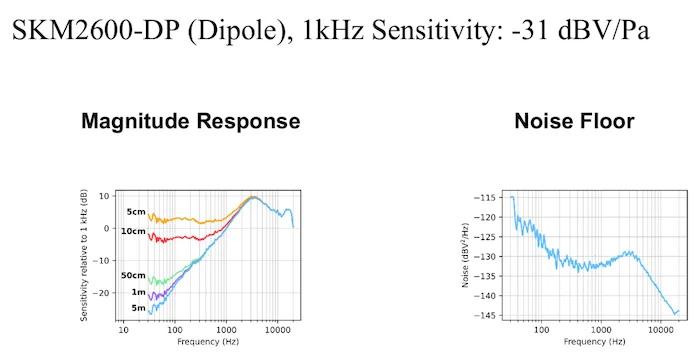
Noise and sensitivity/frequency response of the SKM2600-DP (dipole).
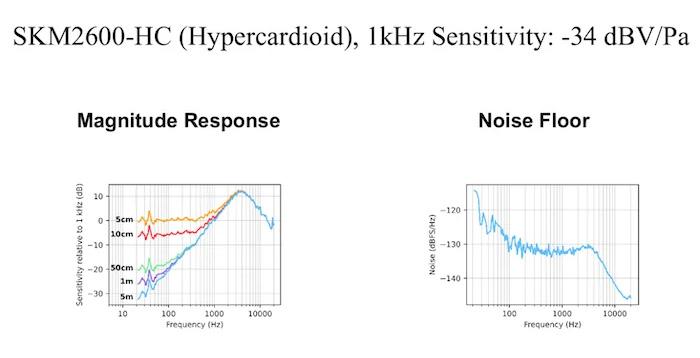
Noise and sensitivity/frequency response of the SKM2600-HC (hypercardioid).
“First and foremost, it's about improving voice isolation and removing background noise,” Gupta explained. “That's what we do best.”
To this end, the SKM2600 is also built around the SKR0600 directional MEMS microphone. The hypercardioid variant delivers directional audio capture while suppressing ambient noise. With a signal-to-noise ratio of 63.5 dBA and a directivity index of 5.3 dB, the module can provide clarity across the audible human frequency range from 20 Hz to 20 kHz.
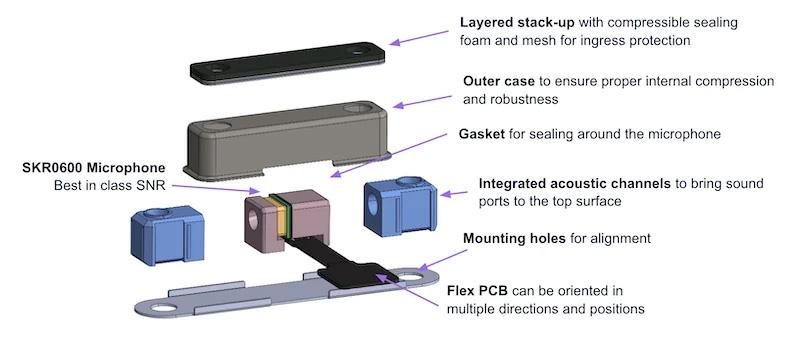
Physical stackup of the SKM2600.
Electrically, the module's single-ended analog output minimizes integration complexity, while its low noise floor of -93.5 dBV (A) ensures accurate audio reproduction. The acoustic overload point of 128 dB SPL allows for operation in high-sound-pressure environments without distortion, supported by a total harmonic distortion of less than 0.1% at 94 dB SPL. The module operates on a low supply current of 115 µA at 1.8 V.
The module employs a layered stack-up structure that enhances acoustic robustness and sealing. The integrated acoustic channels provide precise port alignment with a 12-mm sound port spacing and incorporate an integrated acoustic mesh and compressible sealing foam to achieve IP57-rated protection against dust and water.
Democratizing Directional Audio
Soundskrit believes the SKM2600 and SKM1600 microphone modules may reshape how audio technologies are integrated into consumer devices.
“If you look at who is usually the first to adopt new technology, it can be small- and medium-sized companies that don’t necessarily have audio engineers or a ton of resources,” Gupta said. “But they see the use case and the value to their end customer."
By embedding advanced directionality into hardware rather than relying on software processing or additional components, Soundskrit claims these modules will streamline product development and make directional audio more accessible to developers.



